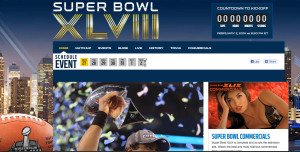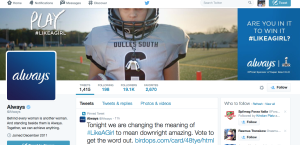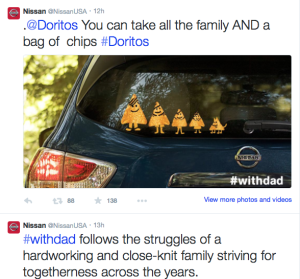Photo: Reflecting the commercial influence on the Super Bowl (source: NFL).
The Super Bowl is a gigantic marketing event. The FIFA World Cup (soccer) and the Olympic Games are the most popular sports events on a global scale measured on attention and media exposure (however, these two events are not one-day events) but the Super Bowl ranks among the top sports events when focus is on one-day events in alignment with another key one-day sports event like the UEFA Champions League final. The Super Bowl is the most important day in the American sports calendar and its huge reach is remarkable given the fact that the event marks the culmination of a national league championship whereas the UEFA Champions League final is the result of competition among teams across Europe.
As people say in the US (I lived in the US myself for four years), the Super Bowl is the most important sports event and it is a one-day only championship in America’s most popular and lucrative sport. With that in mind, the event has become a national ‘special occasion’ in the sports loving country while the international focus on the event has grown as a result of the globalization effect that has characterized the economy of sports over the years. For instance, the NFL has hosted games in London as part of the league’s internationalization strategy and pursuit of expansion.
In the US, the Super Bowl is the most watched television show for what reason the event acts as a premium stage for some of the biggest brands in the World, e.g. Coca-Cola, Anheuser-Busch and Procter & Gamble. According to USA Today’s ‘Super Bowl Ad Meter’ (see here), Anheuser-Busch’s Budweiser commercial about a lost puppy saved by the Budweiser Clydesdales tops the list (see video below – the video has more than 20 mio. hits on YouTube). The articulation and ranking of Super Bowl commercials present two reflections of the amount of hype and boosting of the Super Bowl and the commercial party that comes with this sports event. This development has intensified over the years in our postmodern sports economy, which is shaped by a fragmented media reality and new online platforms with the ability to enhance the corporate and sporting messages. There is a very intense articulation before, during and after the event and companies are smart in terms of exploiting this phenomenon as a part of their strategic process. Companies throw tons of money and considerations to construct a game-winning touchdown and thus become the winner of the brand-circus that is associated with the Super Bowl. 30 seconds of ad time goes for $4.5 mio. and when adding the production and activation costs there is a clear picture of Super Bowl’s enormous commercialization. Compared to other sports events, many eyeballs are tuned in just to watch the commercials and the entertaining extravaganza.
The outcome of the Super Bowl is determined on the playing field where New England Patriots was crowned champions but the outcome of the event is also defined on television and social media platforms. In the table below, the reader(s) will get an idea of the popularity of the event in the US while acknowledging that last year’s Super Bowl between Seattle Seahawks and Denver Broncos had 111,488,000 viewers (Nielsen, 2015,) so that gives evidence of an event that has experienced much progress on television over the years.
| Program | Date | Network | Avg. # of viewers (000) | |
| Super Bowl XLV | Feb. 6, 2011 | FOX | 111,010 | |
| Super Bowl XLIV | Feb. 7, 2010 | CBS | 106,476 | |
| M*A*S*H Special | Feb. 28, 1983 | CBS | 105,970 | |
| Super Bowl XLIII | Feb. 1, 2009 | NBC | 98,732 | |
| Super Bowl XLII | Feb. 3, 2008 | FOX | 97,448 | |
| Super Bowl XXX | Jan. 28, 1996 | NBC | 94,076 | |
(Seidman, 2011)
On social media, NFL enthusiasts have also witnessed much buzz. Take Oreo’s stunt during the blackout in 2013 as one great example. This year, Nissan and Doritos showed an excellent case of co-branding when the two brands engaged in Super Bowl dialogue on the social media platform Twitter. However, Adobe applied the tool Adobe Social to conclude that P & G’s #LikeAGirl scored the most on social media platforms during this year’s Super Bowl. The integration of a multi-media approach to secure a sustainable branding impact is a key finding when I analyze companies’ Super Bowl activities and it is clear that companies utilize social media teams ready to act with the right timing to enhance online viral effects, e.g. the Oreo example above.
Photos: Oreo’s black-out Super Bowl message, P & G’s #LikeAGirl campaign, and Nissan’s #withdad campaign.
From a sports business standpoint, the Super Bowl is the perfect interaction between the league (the NFL), the sponsors, a massive sporting audience (fans) and the fact that the NFL and the Super Bowl reflect a perfect television sport. Based on the competitive balance of the league, every game in America’s most popular sport matters and the clubs generate good money given the colossal injections of broadcasting money and the league format, which creates excitement and uncertainty regarding the outcome of each game. That is what fans want of the span of the entire season. Super Bowl is the epic culmination of the NFL season and it is an event that unites people around family and friends and equipped with good food, drinks and American football. It emphasizes the commercialization of American sports consumption. Just consider how much pizza and how many chicken wings fans consume on Super Bowl Sunday.
The active engagement of companies is central during Super Bowl and that goes way back. Take for instance Apple’s iconic ‘1984’ Macintosh commercial created by the famous movie producer Ridley Scott, see commercial below. The commercial underlined the launch of the Macintosh pc and was only shown once on national television, i.e. during the third quarter of the 1984 Super Bowl. The production costs of Apple’s commercial were gigantic for that era (up to $900,000) but Apple still receives recognition for the commercial today and the commercial presents a fine example of how essential the Super Bowl is for the corporate world.
Source:
Nissan USA’s official Twitter account.
Procter & Gamble’s official Twitter account.
Oreo’s official Twitter account.
Seidman, R. (2011). “Super Bowl XLV Breaks Viewing Record, Averages 111 Million Viewers”, available at http://tvbythenumbers.zap2it.com/2011/02/07/super-bowl-xlv- poised-to-break-viewing-records-ties-1987-with-highest-overnight-ratings-ever/81684/ (accessed on the 16th of April, 2012), uploaded by Robert Seidman on the 7th of February, 2011.




COMMENTS
No comments yet.